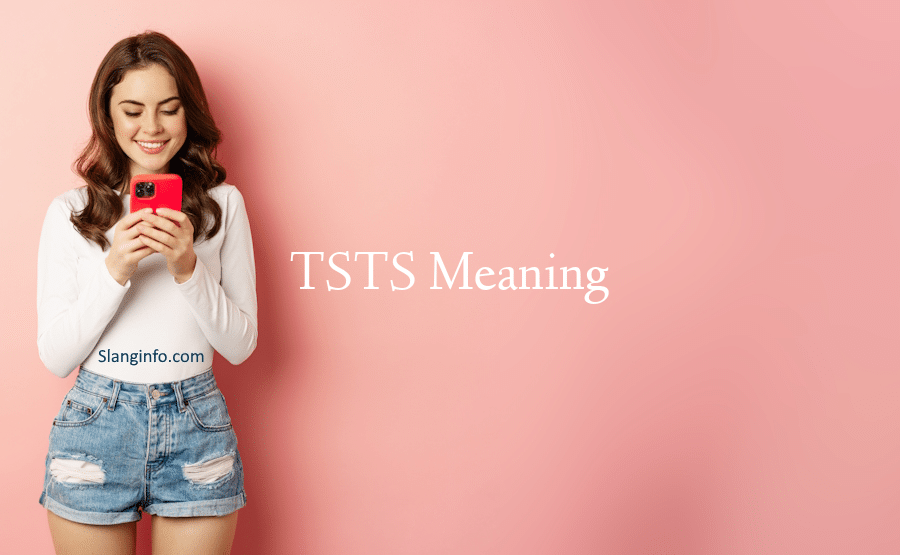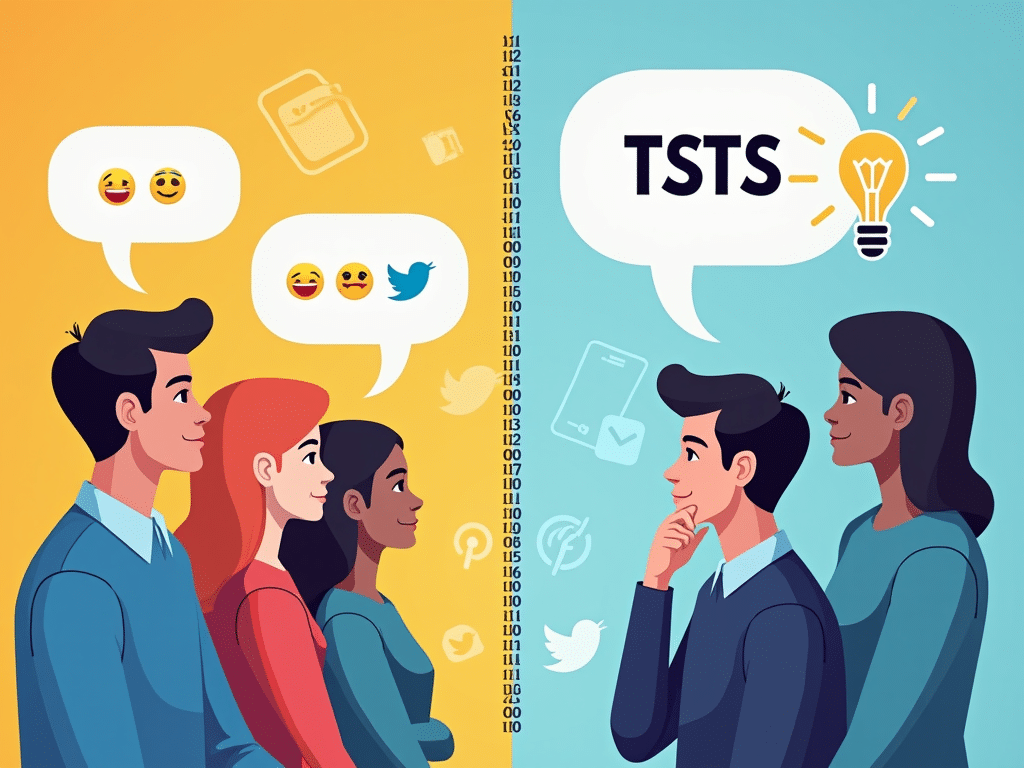Ever been in a conversation that feels like it’s going nowhere? You know, the kind where you’re talking about the weather for the millionth time or discussing what someone had for lunch? Well, there’s a new slang term that’s perfect for these moments: TSTS. This little acronym is making waves in text messages and social media, and it’s all about avoiding those brain-numbing chats.
| Key Takeaways |
|---|
| TSTS stands for “Too Smart To Talk Stupid“ |
| Used to express disinterest in trivial conversations |
| Popular in texting and social media |
| Similar to terms like “TL;DR” or “IDC” |
| Reflects a desire for more meaningful communication |

TSTS Meaning: When You’re Just Not in the Mood for Fluff 🙅♂️
TSTS Meaning: Alright, let’s break it down. TSTS stands for “Too Smart To Talk Stupid.” It’s like saying, “I’m not interested in wasting time on pointless chatter.” It’s the digital equivalent of rolling your eyes at small talk.
Think about it this way: You know how sometimes you’re in the mood for a deep conversation about life, the universe, and everything, but your friend keeps talking about what they had for breakfast? That’s when TSTS comes in handy. It’s a way of saying, “Can we please talk about something more interesting?”
TSTS Meaning in Text: In the world of texting and social media, TSTS might pop up like this:
- Friend: “OMG, did you see what Karen wore to school today?”
- You: “TSTS. Can we talk about the book we’re reading instead?”
Or maybe:
- Someone posts a long rant about drama that doesn’t matter
- You comment: “TSTS 🙄”
It’s a quick way to shut down conversations that you find boring or pointless without being too rude about it.
Also read: Flodging
The Evolution of TSTS: From Eye Rolls to Acronyms 🔄
TSTS didn’t just appear out of thin air. It’s part of a long tradition of internet slang that helps us communicate more efficiently online. Remember when “LOL” first became a thing? TSTS is like that, but for when you’re feeling a bit more… intellectually superior (yeah, it can come off as a bit snobbish if you’re not careful).
This term has been popping up more and more on platforms like Twitter, TikTok, and Instagram. It’s especially popular among people who are tired of the constant stream of trivial information on social media. You know, those moments when your feed is full of what people ate for dinner or their 100th selfie of the day.
TSTS vs. Other Slang Terms for Dismissal: A Battle of the Brush-Offs 🥊
TSTS isn’t the only way to show you’re not interested in a conversation. Let’s compare it to some other popular terms:
- TL;DR (Too Long; Didn’t Read): This one’s for when someone’s being way too wordy.
- IDC (I Don’t Care): A bit more blunt, used when you really couldn’t care less.
- Whatever: The classic dismissal, but in text form.
So why use TSTS instead of these? Well, TSTS has a bit more… flavor. It’s not just saying you don’t care; it’s saying you care about smarter things. It’s like the difference between saying “I’m not hungry” and “I have a refined palate.” Same result, but one sounds fancier.
Also read: KMS Meaning
TSTS in Popular Culture: From Memes to Mainstream 🌟

While TSTS might not be as widespread as FOMO or TBT, it’s definitely making its mark in certain online circles. You might see it in memes about avoiding drama or in tweets from people who are tired of shallow social media content.
For example, imagine a meme with a picture of Einstein and the caption:
“When your friends want to gossip but you’re TSTS 🧠💯”
It’s become a way for people to signal that they’re interested in more substantial conversations. It’s like a secret handshake for folks who want to cut through the noise and get to the good stuff.
Also read: Flauging
The Impact of TSTS on Communication: Raising the Bar or Raising Eyebrows? 🤨
Let’s dive deeper into how TSTS is shaking things up in our digital convos. Is it making us smarter, or just making us sound smarter? Let’s break it down.
TSTS and Social Media: A Love-Hate Relationship 💔❤️
Social media is like a buffet of information – some of it’s gourmet, and some of it’s… well, junk food for your brain. TSTS is like that friend who’s always trying to drag you away from the candy and towards the veggies. It’s a pushback against the endless stream of cat videos and lunch photos.
But here’s the thing: sometimes, those “stupid” conversations are what bring people together. Ever bonded with someone over a silly meme or a shared love for bad reality TV? Yeah, TSTS might make you miss out on those moments.
The TSTS Effect: How It’s Changing Our Online Behavior
- Quality Over Quantity: People might think twice before posting or starting a convo, aiming for more substance.
- Intellectual Pressure: There’s a bit of pressure to always be “on” and ready for deep talks.
- Potential for Snobbery: Let’s be real, overusing TSTS can make you look like a bit of a know-it-all.
Using TSTS: The Do’s and Don’ts
Alright, so you want to use TSTS in your texts. Cool. But before you go throwing it around like confetti, here are some tips:
Do:
- Use it when you genuinely want to steer a conversation to more meaningful topics
- Save it for friends who get your sense of humor
- Be ready to back it up with an interesting topic of your own
Don’t:
- Overuse it – nobody likes a constant buzzkill
- Use it in professional settings (your boss might not appreciate it)
- Forget that sometimes, “stupid” talk is just people trying to connect
TSTS and the Evolution of Internet Slang: What’s Next? 🔮
TSTS is just one player in the ever-changing game of internet slang. It’s part of a bigger trend where we’re constantly coming up with new ways to express ourselves online. Just like we went from “LOL” to “💀” to show we’re laughing, who knows what we’ll use after TSTS?
If you’re curious about other text abbreviations and how they’re changing the way we talk online, check out our article on decoding text abbreviations. It’s wild how creative we get with just a few letters!
Conclusion: To TSTS or Not to TSTS? 🤔
At the end of the day, TSTS is just another tool in your communication toolbox. It can be great for cutting through the fluff and getting to more interesting convos. But like any tool, it’s all about how you use it.
Remember, being smart isn’t just about avoiding “stupid” talk. It’s about knowing when to dive deep and when to just enjoy a lighthearted chat. Sometimes, talking about the weather or what you had for lunch is just what you need to connect with someone.
So, next time you’re tempted to drop a TSTS in the chat, maybe take a second to think: Is this really a dumb conversation, or am I missing out on a chance to connect? Who knows, that “stupid” talk might lead to something brilliant.
Also read: FRFR
FAQs
Q: Is TSTS rude to use?
A: It can be if overused or used in the wrong context. Use it sparingly and with people who get your humor.
Q: Can TSTS be used positively?
A: Absolutely! Use it to invite deeper, more meaningful conversations with your friends.
Q: What if someone uses TSTS on me?
A: Don’t take it personally. Take it as a challenge to bring up a more engaging topic!
Stay smart out there, folks. And remember, sometimes the smartest thing you can do is just listen and enjoy the simple stuff. Not every convo needs to be worthy of a TED Talk! 😉







